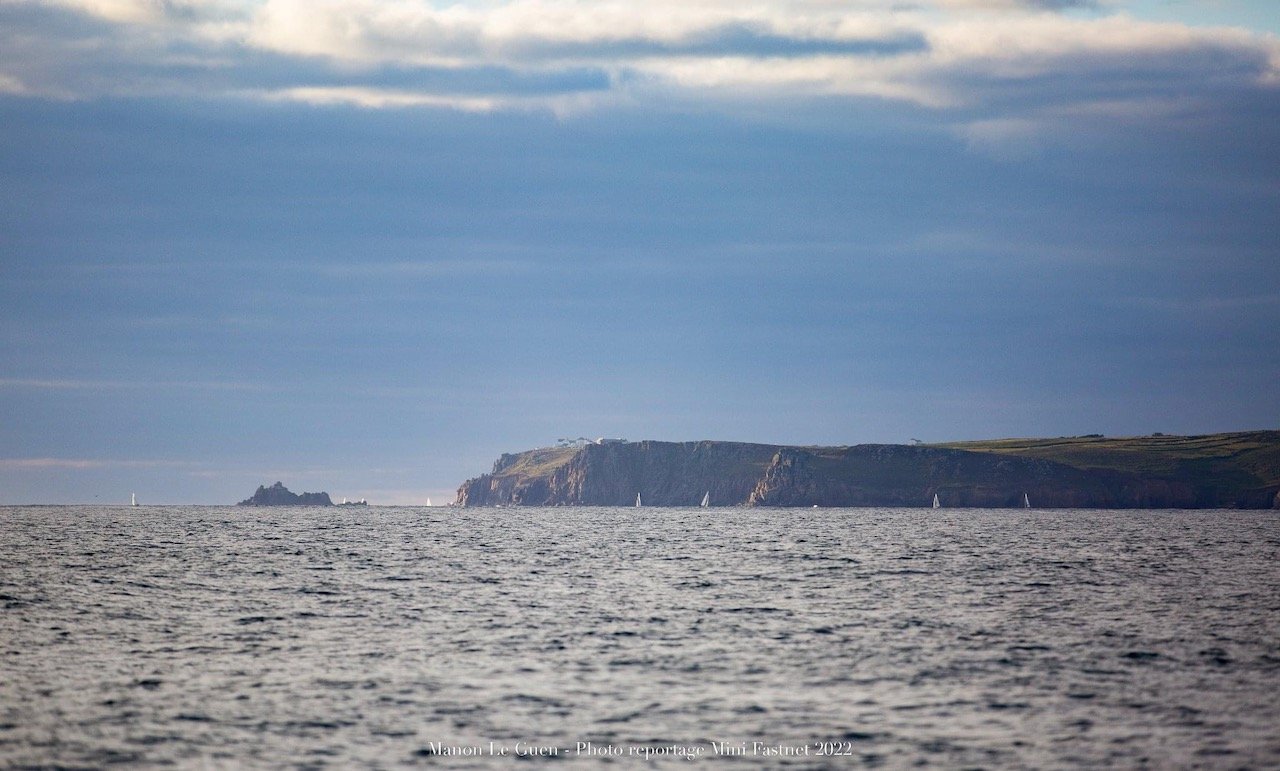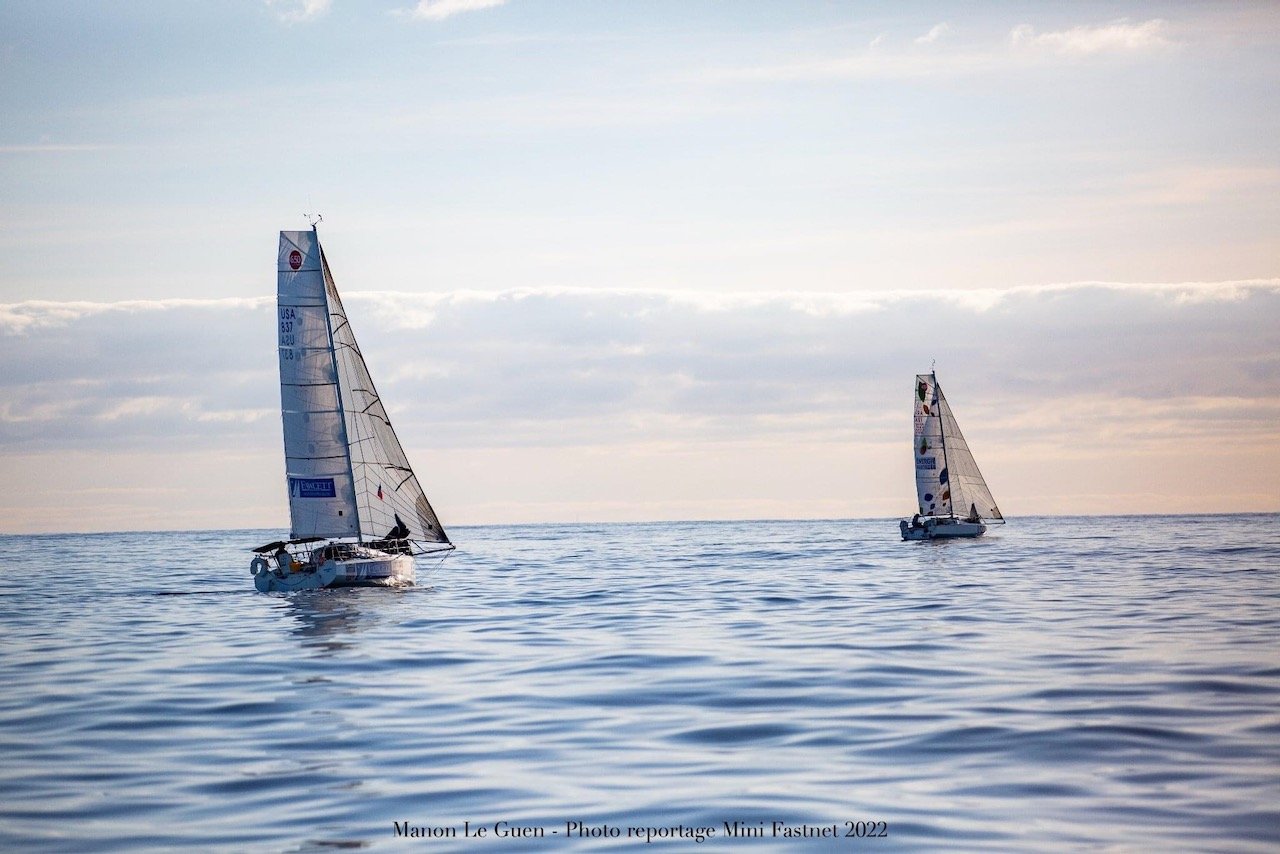Mini-Fastnet After Action Report Part II
Rounding Land’s End and a light wind race
Eight hours into the first day of the Mini-Fastnet race, Yannick and I were with the top pack of the fleet. Sitting in approximately 11th place according to the tracker (this can vary a bit depending on the wind direction), we were feeling great about this race after 35 nm of close sailing.
Terminal Leave in 11th place! (Series is blue, Protos in Gold)
Passing the island of Ushant to the west, the fleet sailed upwind on starboard tack into the English Channel. This next segment of the course was about 100 nm long towards the west coast of England.
Towards the evening, we entered the busy shipping lanes just east of the main Traffic Separation Scheme (TSS) at the entrance to the English Channel. Around 2000, with the sun still not set yet, the wind shifted left and most of the boats tacked onto port to avoid sailing into the restricted TSS zone.
Throughout most of the first night we stayed on port tack and could see masthead navigation lights from our competitors all around us. We slowly were headed but didn’t want to tack too early and lose our advantage and leverage on the fleet. Thinking the wind was going to continue to shift right, we held out until we were the farthest right series boat and finally tacked around 0445. At the time we didn’t know our exact ranking, but the tracker states we were in 12th place at the moment.
Later that morning on Monday (13 June) the wind started to lighten and shift left. The temperature rose and became a hot, mostly sunny day with just a few clouds. Puffs would come and go. Sometimes we could hit 5 kts of boat speed, other times we would be drifting with the sails flapping from the swells. The wind initially died towards the front of the fleet, so the boats farther back slowly crept up over the horizon.
Light air and a wind shift moved Terminal Leave few places back to 18th place
During these few hours, the boats to our left gained from the wind direction and wind filling in first on their side. Even though we could see the boats speed up, there was nothing we could do except wait for our own breeze. At the time, the boats looked much further away than how it is depicted on the tracker. This was hard to watch at the time, but we had only lost a few spots on the leaderboard and were still in the hunt.
The next stage of the course required the fleet to pass two marks to port, west of England’s mainland, but east of the Isles of Scilly and the TSS. Since this area was 4 nm at its narrowest, this was certainly going to force the fleet back together from being spread out over the past day.
With adverse current, the fleet headed towards the English coast. The tide first turned in the channel which allowed some relief in the shallower waters. Since there are no required marks of the course to leave to starboard, it was up to each skipper how close to go inshore. At its narrowest, there was a section less than half a mile wide that most of the boats sailed through.
Terminal Leave (farthest boat right) sailing around Land’s End
Rounding Land’s End was an exhilarating experience I certainly will never forget. Still an upwind sail, in about 6-8 kts of wind, we were actively tacking and crossing multiple boats. Every time we went inshore, we gained, every time we went just a little bit farther off shore we lost a few boat lengths. For example, even going just three extra boat lengths further off shore for a lane of clear air could send you back double that distance.
This led to all of the boats to compete for who could go farther inshore. [Note: the tracker does not have the necessary level of detail to see this] I wish I could have taken a video of this experience, but Yannick and I were hyper focused on the racing and pushing the boat as hard as we could for every inch. Many times we were the farthest boat inshore and tacking just a few meters before the rocks. Despite not having detailed enough charts of this specific area (never making that mistake again!), Yannick’s experience in this area helped get us through unscathed. Most commonly our only indication on how far in we could sail was the location of crab pots. The theory goes, if a power boat can drop off a pot in the water, then it should be deep enough for us. Chances are if there are any rocks just below the surface, the fishermen won’t put a pot down.
As we rounded Land’s End around 2130, the fleet was still spread out. The boats in the back missed some of the current relief and were paying for it in the deep water. The sun was setting and darkness began to fall across the fleet. We were still hugging the coastline and the moon was almost full, but we could not sail as close to the rocks as in day light.
The cliffs and rocks of Land’s End
Nightfall at Land’s End
Just before midnight, the wind began to shift right so the fleet started to head offshore. The breeze had lightened up significantly for the boats that were just ahead, so we all converged. The glow of the masthead lights was green, red, and white going in all directions. There were many port-starboard crossings, and windward-leeward situations since some boats tried to sail closer to the wind, while others hoisted a code zero and bore off in search of new wind. Every boat was fighting for a slight advantage to however their boat preferred sailing in this light wind.
By 0330 that Tuesday morning (14 June), we rounded Bann Shoal marker which marked the north eastern edge of the restricted TSS zone. Now we just had to stay north of the TSS, which was not too difficult baring any major wind shifts. From here it was open water sailing across the Celtic Sea to Ireland!
Tuesday was a day of light air sailing. Most of the morning we tried to sail with either the jib or code 0. The wind started shifting a little right and in the late morning/afternoon we could fly the spinnaker.
At about 1350 on Tuesday, the race organization finally made the call to shorten the course. No longer would we race to Ireland and round the Fastnet rock and lighthouse. We were frustrated with the news because of the decision, but more so because of the lack of reasoning provided at the time. Ultimately, the decision was made due to a combination of the slow race conditions so far, the light winds forecasted, and a large low-pressure system approaching the region. Essentially, the fleet would drift slowly to the Fastnet, then be slammed by this storm.
This decision was all about risk management and shorting a 600 nm race by only 100 nm to prevent possible catastrophe. Indeed, the right decision to make at the time. Furthermore, the IMOCA fleet (60’ high performance solo racing boats designed to sail non-stop around the world) paused their race to Iceland and either turned around or took shelter on moorings due to this weather system.
Instead of rounding the Fastnet, the fleet would round a virtual waypoint that was provided to us over the VHF radio. The support boats spent the next few hours calling all 85 Minis individually to confirm each skipper understood the course correction. This should not have been difficult since the support boats called us each morning at 0800 to receive position and status reports, however it became painful when some of the boats were not monitoring the radio or correct channels. All but one boat finally got the message and we continued racing. The lone boat who was not listening to the radio finally realized their error when they reach Ireland…they were forced to pull into port by the race officials.
Course change: New virtual waypoint
At 1350, the time of the course change announcement, we were sailing along the rhumb line. Even with the change of course, this line did not move since the bearing reminded constant. We had just gone through another light patch, causing the fleet to once again compress. These compressions were virtually an unofficial restart of the race. After 53 hours of competition, it was the start of a whole new race! According the tracker we were in 23th place, but realistically it was still anyone’s race since we were along a virtual line perpendicular to the course axis. The wind velocity and direction changes were frequent, and boats were constantly passing each other multiple times over.
The light air was effecting everyone mentally. The conversations on the VHF radio became increasingly frustrated at the lack of wind. There was a direct correlation between less wind velocity and more music being played over the radio…most of it American rock/pop music (not played by me). We even had an occasional Irish performance. Yes the fleet might have been losing their minds, but they were still racing just a hard as on day one.
Part 3 of this AAR coming soon!
Thank you for reading this blog post! If you enjoyed it, please share this post with your friends and family.
This racing is only possible with donations from supporters. Want to help my mission to race in the Mini Transat to raise awareness for U.S. Patriot Sailing? Please donate through my GoFundMe page here: https://gofund.me/dc565273
Thank you for your support!




















